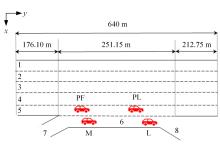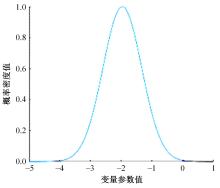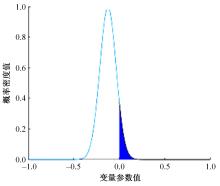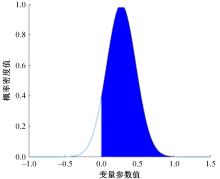Journal of Jilin University(Engineering and Technology Edition) ›› 2024, Vol. 54 ›› Issue (4): 883-889.doi: 10.13229/j.cnki.jdxbgxb.20220614
Previous Articles Next Articles
Analysis of merging behavior based on random parameter model with heterogeneity in variances
- College of Automobile and Traffic Engineering,Nanjing Forestry University,Nanjing 210037,China
CLC Number:
- U491.2
| 1 | 孙剑,李克平,杨晓光.拥挤交通流交织区车道变换行为仿真[J].系统仿真学报,2009,21(13):4174-4178, 4182. |
| Sun Jian, Li Ke-Ping, Yang Xiao-guang. Simulation of lane-changing behavior in congested traffic flow of the interweaving area[J]. Journal of System Engineering Simulation, 2009, 21(13): 4174-4178, 4182. | |
| 2 | Chang G L, Kao Y M. An empirical investigation of macroscopic lane-changing characteristics on uncongested multilane freeways[J]. Transportation Research Part A: General, 1991, 25(6): 375-389. |
| 3 | Laval J A, Leclercq L. Microscopic modeling of the relaxation phenomenon using a macroscopic lane-changing model[J]. Transportation Research Part B: Methodological, 2008, 42(6): 511-522. |
| 4 | Bham G H. A simple lane change model for microscopic traffic flow simulation in weaving sections[J]. Transportation Letters: the International Journal of Transportation Research, 2011, 3(4): 231-251. |
| 5 | Hou Y, Edara P, Sun C. A genetic fuzzy system for modeling mandatory lane changing[C]//The 15th International IEEE Conference on Intelligent Transportation Systems (ITSC), New York, United States, 2012: 1044-1048. |
| 6 | Rahman M, Chowdhury M, Xie Y, et al. Review of microscopic lane-changing models and future research opportunities[J]. Ieee Transactions on Intelligent Transportation Systems, 2013, 14(4): 1942-1956. |
| 7 | Li G, Yang Z, Yu Q, et al. Characterizing heterogeneity among merging positions: comparison study between random parameter and latent class accelerated hazard model[J]. Journal of Transportation Engineering, Part A: Systems, 2021, 147(6):No. 4021029. |
| 8 | Zhou H, Sun Y, Qin X, et al. Modeling discretionary lane-changing behavior on urban streets considering drivers' heterogeneity[J]. Transportation Letters, 2020, 12(3): 213-222. |
| 9 | Keyvan-Ekbatani M, Knoop V L, Daamen W. Categorization of the lane change decision process on freeways[J]. Transportation Research Part C: Emerging Technologies, 2016, 69: 515-526. |
| 10 | Li G. Application of finite mixture of logistic regression for heterogeneous merging behavior analysis[J]. Journal of Advanced Transportation, 2018(7): No.1436521. |
| 11 | Li G, Pan Y Y, Yang Z, et al. Modeling vehicle merging position selection behaviors based on a finite mixture of linear regression models[J]. IEEE Access, 2019, 7: 158445-158458. |
| 12 | Mannering F, Shankar V, Bhat C R. Unobserved heterogeneity and the statistical analysis of highway accident data[J]. Analytic Methods in Accident Research, 2016, 11: 1-16. |
| 13 | Seraneeprakarn P, Huan G S, Shankar V, et al. Occupant injury severities in hybrid-vehicle involved crashes: A random parameters approach with heterogeneity in means and variances[J]. Analytic Methods in Accident Research, 2017, 15: 41-55. |
| 14 | Yu M, Zheng C J, Ma C X. Analysis of injury severity of rear-end crashes in work zones: A random parameters approach with heterogeneity in means and variances[J]. Analytic Methods in Accident Research, 2020, 27:No. 100126. |
| 15 | Chen T Y, Shi X P, Wong Y D. Key feature selection and risk prediction for lane-changing behaviors based on vehicles' trajectory data[J]. Accident Analysis and Prevention, 2019, 129: 156-169 |
| 16 | 李华民, 黄海军, 刘剑锋. 混合Logit模型的参数估计与应用研究[J]. 交通运输系统工程与信息, 2010, 10(5): 73-78. |
| Li Hua-min, Huang Hai-jun, Liu Jian-feng. Parameter estimation and application research of mixed Logit model[J]. Journal of Transportation Systems Engineering and Information Technology, 2010, 10(5): 73-78. | |
| 17 | 宋栋栋,杨小宝,祖兴水,等.基于均值异质性随机参数Logit模型的城市道路事故驾驶员受伤严重程度研究[J].交通运输系统工程与信息,2021,21(3): 214-220. |
| Song Dong-dong, Yang Xiao-bao, Zu Xing-shui, et al. Research on the injury severity of drivers in urban road accidents based on mean heterogeneity random parameter Logit model[J]. Journal of Transportation Systems Engineering and Information Technology, 2021, 21(3): 214-220. | |
| 18 | 王荣本,游峰,崔高健,等.车辆安全换道分析[J].吉林大学学报:工学版,2005,35(2):179-182. |
| Wang Rong-ben, You Feng, Cui Jian-gao, et al. Analysis on lane-changing safety of vehicle[J]. Journal of Jilin University(Engineering and Technology Edition), 2005,35 (2): 179-182. | |
| 19 | 贾洪飞,谭云龙,李强,等.考虑驾驶员特征的快速路合流区间隙接受模型构建[J].吉林大学学报:工学版,2015,45(1):55-61. |
| Jia Hong-fei, Tan Yun-long, Li Qiang, et al. Gap acceptance model of expressway weaving area based on driver characteristics[J]. Journal of Jilin University(Engineering and Technology Edition), 2015, 45(1): 55-61. |
| [1] | Jie HE,Chang-jian ZHANG,Xin-tong YAN,Chen-wei WANG,Yun-tao YE. Analyzing traffic crash risk of freeway characteristics based on micro⁃kinetic parameters [J]. Journal of Jilin University(Engineering and Technology Edition), 2024, 54(1): 162-172. |
| [2] | Liu YANG,Chuang-ye WANG,Meng-yan WANG,Yang CHENG. Traffic flow characteristics of six⁃lane freeways with a dedicated lane for automatic cars [J]. Journal of Jilin University(Engineering and Technology Edition), 2023, 53(7): 2043-2052. |
| [3] | Yi HE,Chang-xin SUN,Jian-hua PENG,Chao-zhong WU,Liang JIANG,Ming MA. Risk behaviors and influencing factors of cargo electric tricycles [J]. Journal of Jilin University(Engineering and Technology Edition), 2023, 53(2): 413-420. |
| [4] | Jie-yu ZHU,Yan-li MA. Real-time risk assessment method of multi-vehicle interaction at merging area [J]. Journal of Jilin University(Engineering and Technology Edition), 2022, 52(7): 1574-1581. |
| [5] | DAI Cun-jie,LI Yin-zhen,MA Chang-xi,CHAI Huo,MU Hai-bo. Multi-criteria optimization for hazardous materials distribution routes under uncertain conditions [J]. Journal of Jilin University(Engineering and Technology Edition), 2018, 48(6): 1694-1702. |
| [6] | SUN Zong-yuan, FANG Shou-en. Hierarchical clustering algorithm of moving vehicle trajectories in entrances and exits freeway [J]. 吉林大学学报(工学版), 2017, 47(6): 1696-1702. |
| [7] | LI Peng-hui, ZHANG Wen-hui, HU Meng-xia, LI Yi-bing, WU Biao. Analysis on saccade behavior of driver during overtaking on freeway [J]. 吉林大学学报(工学版), 2016, 46(1): 114-119. |
| [8] | SUN Lu, XU Jian, CUI Xiang-min. Panel data models for analysis and prediction of crash count [J]. 吉林大学学报(工学版), 2015, 45(6): 1771-1778. |
| [9] | XU Jian, SUN Lu. Modeling of excess zeros issue in crash count andysis [J]. 吉林大学学报(工学版), 2015, 45(3): 769-775. |
| [10] | YANG Qing-fang, MA Ming-hui, YANG Ju-fen, BING Qi-chun, LIANG Shi-dong. Analysis of the traffic flow operating stability on highway [J]. 吉林大学学报(工学版), 2014, 44(6): 1596-1603. |
| [11] | JIN Li-sheng, WANG Yan, LIU Jing-hua, WANG Ya-li, ZHENG Yi. Front vehicle detection based on Adaboost algorithm in daytime [J]. 吉林大学学报(工学版), 2014, 44(6): 1604-1608. |
| [12] | JIN Li-sheng,NIU Qing-ning,LIU Jing-hua,QIN Yan-guang,YU Huan-huan. Driver cognitive distraction detection in different road lines [J]. 吉林大学学报(工学版), 2014, 44(3): 642-647. |
| [13] | ZHAN Wei, LYU Qing, SHANG Yue-quan. Analysis of gray-Markov forecasting for traffic accidents in highway tunnel group region [J]. 吉林大学学报(工学版), 2014, 44(01): 62-67. |
| [14] | XU Cheng-cheng, LIU Pan, WANG Wei, LI Zhi-bin. Real time crash risk prediction model on freeways under nasty weather conditions [J]. 吉林大学学报(工学版), 2013, 43(01): 68-73. |
| [15] | ZHANG Wen-hui, XU Hong-guo. Speed-limit scheme of traffic accident scene road section on freeway [J]. 吉林大学学报(工学版), 2012, 42(02): 316-320. |
|
||








